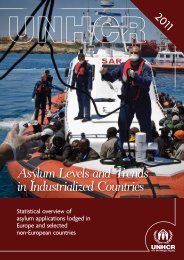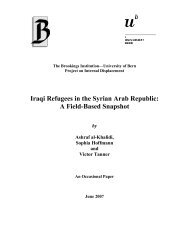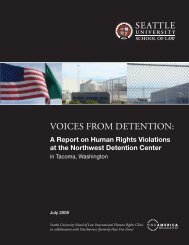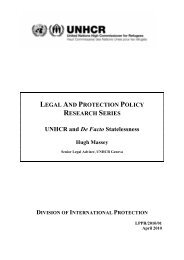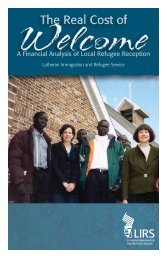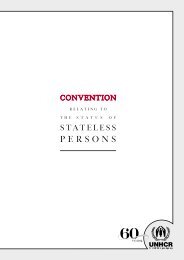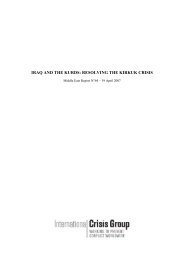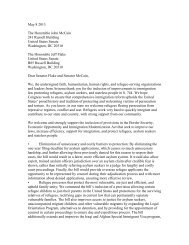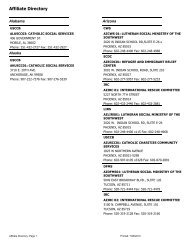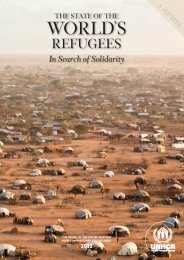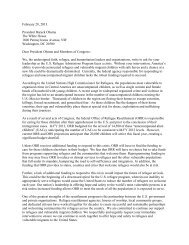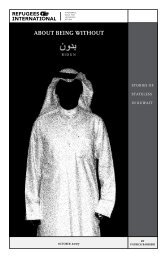Protecting the Rights of Stateless Persons - UNHCR
Protecting the Rights of Stateless Persons - UNHCR
Protecting the Rights of Stateless Persons - UNHCR
You also want an ePaper? Increase the reach of your titles
YUMPU automatically turns print PDFs into web optimized ePapers that Google loves.
<strong>Protecting</strong> <strong>the</strong> <strong>Rights</strong> <strong>of</strong><br />
<strong>Stateless</strong> <strong>Persons</strong><br />
T h e 1 9 5 4 C o n v e n t i o n r e l a t i n g t o t h e S t a t u s o f S t a t e l e s s P e r s o n s
A Personal APPeal<br />
from <strong>the</strong> United<br />
Nations high<br />
Commissioner<br />
for refugees<br />
Today, millions <strong>of</strong> people around <strong>the</strong><br />
world face serious difficulties owing to<br />
statelessness. The Convention relating to<br />
<strong>the</strong> Status <strong>of</strong> <strong>Stateless</strong> <strong>Persons</strong> provides<br />
a framework for States to assist stateless<br />
people – allowing <strong>the</strong>m to live in security<br />
and dignity until <strong>the</strong>ir situation can be<br />
resolved. Presently, very few States are<br />
parties to this instrument. We need to<br />
change that. I call on States to accede<br />
to <strong>the</strong> Convention and pledge <strong>the</strong> full<br />
support <strong>of</strong> my Office to governments to<br />
help implement its provisions.<br />
António Guterres
P R O M O T I N G R E C O G N I T I O N ,<br />
E N H A N C I N G P R O T E C T I O N<br />
Nationality is a legal bond between a person and a State. Nationality provides<br />
people with a sense <strong>of</strong> identity but, more importantly, enables <strong>the</strong>m to<br />
exercise a wide range <strong>of</strong> rights. The lack <strong>of</strong> any nationality, statelessness, can<br />
<strong>the</strong>refore be harmful, in some cases devastating to <strong>the</strong> lives <strong>of</strong> <strong>the</strong> individuals<br />
concerned.<br />
Despite international recognition <strong>of</strong> <strong>the</strong> right to a nationality, new cases <strong>of</strong><br />
statelessness have continued to arise. Tackling statelessness still poses a major<br />
challenge in <strong>the</strong> 21st century. There are an estimated 12 million stateless people<br />
around <strong>the</strong> world today.<br />
While some stateless persons are refugees at <strong>the</strong> same time, most are not.<br />
<strong>Stateless</strong> persons who are also refugees are entitled to <strong>the</strong> international protection<br />
afforded by <strong>the</strong> 1951 Convention relating to <strong>the</strong> Status <strong>of</strong> Refugees (“1951<br />
Convention”). To address <strong>the</strong> protection problems faced by stateless persons, in<br />
particular those who are not refugees, <strong>the</strong> international community adopted <strong>the</strong><br />
1954 Convention relating to <strong>the</strong> Status <strong>of</strong> <strong>Stateless</strong> <strong>Persons</strong> (“1954 Convention”).<br />
This treaty aims to regulate <strong>the</strong> status <strong>of</strong> stateless persons and to ensure <strong>the</strong><br />
widest possible enjoyment <strong>of</strong> <strong>the</strong>ir human rights. The Convention complements<br />
provisions <strong>of</strong> international human rights treaties.<br />
A growing number <strong>of</strong> States are turning to <strong>the</strong> 1954 Convention as a framework<br />
for <strong>the</strong> protection <strong>of</strong> stateless persons. This reflects understanding that<br />
<strong>the</strong> 1954 Convention relating to <strong>the</strong> Status <strong>of</strong> <strong>Stateless</strong> <strong>Persons</strong> is <strong>the</strong> only legal<br />
instrument that formally establishes <strong>the</strong> international legal status <strong>of</strong> “stateless<br />
persons”. The Convention also addresses many practical concerns relating to <strong>the</strong><br />
protection <strong>of</strong> stateless persons – such as access to travel documents – that are<br />
not dealt with elsewhere in international law. While <strong>the</strong> 1954 Convention had<br />
only 65 States Parties on 1 July 2010, more States are acknowledging that it is<br />
a central component <strong>of</strong> <strong>the</strong> international regime for enhancing <strong>the</strong> protection<br />
<strong>of</strong> <strong>the</strong> rights <strong>of</strong> stateless persons.<br />
P r o t e c t i n g t h e R i g h t s o f S t a t e l e s s P e r s o n s 1
W h y d o s T A T E l e s s P E R s O N s<br />
N E E d P R O T E C T I O N ?<br />
The Universal Declaration <strong>of</strong> Human <strong>Rights</strong> affirms that “everyone has<br />
<strong>the</strong> right to a nationality”, <strong>the</strong>reby acknowledging <strong>the</strong> legal and practical<br />
importance <strong>of</strong> nationality for <strong>the</strong> enjoyment <strong>of</strong> human rights. Governments<br />
must <strong>the</strong>refore work to make certain that everyone holds a nationality. Despite<br />
this and o<strong>the</strong>r provisions <strong>of</strong> international human rights law, many people<br />
never acquire or are deprived <strong>of</strong> <strong>the</strong>ir nationality. When some people remain<br />
excluded, <strong>the</strong>ir statelessness leaves <strong>the</strong>m vulnerable. Because <strong>the</strong>y lack <strong>the</strong><br />
bond <strong>of</strong> nationality with any State, stateless persons need special attention and<br />
protection to ensure that <strong>the</strong>y are able to exercise <strong>the</strong>ir basic rights.<br />
For instance, a particular concern for stateless persons is <strong>the</strong> difficulty that <strong>the</strong>y<br />
face in obtaining identity and travel documents, which not only impedes <strong>the</strong>ir<br />
ability to travel, but can also cause many problems in day-to-day life and may<br />
in some cases lead to <strong>the</strong> prolonged detention <strong>of</strong> <strong>the</strong> individual. <strong>Stateless</strong>ness<br />
prevents people from fulfilling <strong>the</strong>ir potential and may have severe knock-on<br />
effects for societal cohesion and stability. It may even cause communal tensions<br />
and displacement. Promoting recognition and enhancing protection <strong>of</strong> stateless<br />
persons are means to respond to such concerns.<br />
2<br />
P r o t e c t i n g t h e R i g h t s o f S t a t e l e s s P e r s o n s<br />
<strong>Stateless</strong> people are <strong>of</strong>ten without a legal<br />
status and feel left out <strong>of</strong> society. Brought to<br />
Kenya from Sudan during <strong>the</strong> colonial period,<br />
Nubians were generally not considered to be<br />
nationals <strong>of</strong> Kenya following independence. Says<br />
one <strong>of</strong> <strong>the</strong>se two unemployed young Nubian<br />
men: “People call us foreigners when we have<br />
lived here for over 100 years. They tell us to go<br />
back to Sudan, but this has been our homeland<br />
for generations. Where will we go?”<br />
<strong>UNHCR</strong>/G. Constantine
I s T H E 1 9 5 4 C O N v E N T I O N s T I l l<br />
R E l e v A N T I N T O d a y ’ s W O R l d ?<br />
Yes, absolutely. <strong>Stateless</strong>ness is still a widespread problem today. With <strong>the</strong><br />
growing awareness <strong>of</strong> <strong>the</strong> global impact <strong>of</strong> statelessness on individuals and<br />
societies, both governments and <strong>the</strong> international community are increasingly<br />
turning to <strong>the</strong> UN <strong>Stateless</strong>ness Conventions for guidance. The 1954 Convention<br />
remains <strong>the</strong> primary international instrument that regulates <strong>the</strong> status <strong>of</strong><br />
non-refugee stateless persons and ensures that stateless persons enjoy human<br />
rights without discrimination. It provides <strong>the</strong> stateless with an internationally<br />
recognized legal status, <strong>of</strong>fers <strong>the</strong>m access to travel documents, identity papers<br />
and o<strong>the</strong>r basic forms <strong>of</strong> documentation, and sets out a common framework<br />
with minimum standards <strong>of</strong> treatment for stateless persons. Accession to <strong>the</strong><br />
1954 Convention <strong>the</strong>refore allows States to demonstrate <strong>the</strong>ir commitment to<br />
human rights, gives individuals access to protection and mobilizes international<br />
support for <strong>the</strong> State to adequately deal with <strong>the</strong> protection <strong>of</strong> stateless persons.
P R O T E C T I N G S T A T E L E s s P E R S O N S<br />
W I T H T H E 1 9 5 4 C O N V E N T I O N<br />
Who does <strong>the</strong> 1954 ConveNTion proteCT?-<br />
The 1954 Convention recognises <strong>the</strong> international legal status <strong>of</strong> “stateless<br />
persons”. Article 1 establishes <strong>the</strong> definition <strong>of</strong> a stateless person in international<br />
law: someone “who is not considered as a national by any State under<br />
<strong>the</strong> operation <strong>of</strong> its law”. This definition is now also recognised to be customary<br />
international law. <strong>Persons</strong> who satisfy <strong>the</strong> definition are entitled to certain rights<br />
and duties contained in <strong>the</strong> 1954 Convention. The Convention does not cover<br />
so-called de facto stateless persons for whom no universally accepted definition<br />
exists in international law. However, de facto stateless persons are entitled to<br />
protection under international human rights law. <strong>Stateless</strong> refugees are covered<br />
by <strong>the</strong> 1951 Convention relating to <strong>the</strong> Status <strong>of</strong> Refugees and should be treated<br />
in accordance with international refugee law.<br />
StateleSS persoNS’ righTS under <strong>the</strong> 1954 ConveNTion-<br />
The 1954 Convention is based on a core principle: no stateless person should<br />
be treated worse than any foreigner who possesses a nationality. In addition<br />
<strong>the</strong> Convention acknowledges that stateless persons are more vulnerable<br />
than o<strong>the</strong>r foreigners. It <strong>the</strong>refore provides for a series <strong>of</strong> special measures for<br />
stateless persons.<br />
The 1954 Convention guarantees stateless persons a right to administrative assistance<br />
(Article 25), a right to identity and travel documents (Articles 27 and<br />
28) and exempts <strong>the</strong>m from reciprocity requirements (Article 7). These tailormade<br />
provisions are designed to deal with <strong>the</strong> particular difficulties faced by<br />
stateless persons due to <strong>the</strong>ir lack <strong>of</strong> any nationality, for instance by providing<br />
for a mutually-recognised travel document for stateless persons to function in<br />
lieu <strong>of</strong> a passport. These matters are not regulated elsewhere in international<br />
law and are among <strong>the</strong> core legal benefits for stateless persons under <strong>the</strong> 1954<br />
Convention.<br />
Considering <strong>the</strong> plight <strong>of</strong> stateless people, <strong>the</strong> Convention stipulates that <strong>the</strong>y<br />
must be treated like nationals <strong>of</strong> <strong>the</strong> State with regard to certain rights such<br />
4<br />
P r o t e c t i n g t h e R i g h t s o f S t a t e l e s s P e r s o n s
as freedom <strong>of</strong> religion or elementary education. It must be stressed that <strong>the</strong><br />
Convention pursues a nuanced approach, specifying that some guarantees apply<br />
to all stateless people while o<strong>the</strong>rs are reserved to stateless persons lawfully<br />
present or lawfully staying in <strong>the</strong> territory. The 1954 Convention thus echoes<br />
human rights standards contained in o<strong>the</strong>r international instruments and provides<br />
guidance on how such standards are to be implemented for stateless<br />
persons. As set out in Article 2 <strong>of</strong> <strong>the</strong> 1954 Convention, all stateless persons<br />
have <strong>the</strong> duty to obey <strong>the</strong> laws and regulations <strong>of</strong> <strong>the</strong> country in which <strong>the</strong>y<br />
find <strong>the</strong>mselves.<br />
It is important to note that <strong>the</strong> enjoyment <strong>of</strong> <strong>the</strong> rights guaranteed under <strong>the</strong><br />
1954 Convention does not equate to possession <strong>of</strong> a nationality. This is why <strong>the</strong><br />
1954 Convention calls upon States to facilitate <strong>the</strong> naturalization (Article 32) <strong>of</strong><br />
stateless persons. Once <strong>the</strong>y acquire an effective nationality, stateless persons<br />
are no longer stateless: <strong>the</strong>ir plight has come to an end.<br />
Does <strong>the</strong> 1954 ConveNTion require States to graNT STateleSS persoNSa<br />
nationaliTY?-<br />
The 1954 Convention does not establish a right for stateless persons to acquire<br />
<strong>the</strong> nationality <strong>of</strong> a specific State. However, because stateless persons have<br />
no State to protect <strong>the</strong>m, <strong>the</strong> Convention requires States Parties to facilitate<br />
<strong>the</strong> integration and naturalization <strong>of</strong> stateless persons as far as possible, for<br />
example by expediting and reducing <strong>the</strong> costs <strong>of</strong> naturalization proceedings<br />
for stateless persons. At a more general level, human rights law recognises <strong>the</strong><br />
right to a nationality – set out, for example, in <strong>the</strong> Universal Declaration <strong>of</strong><br />
Human <strong>Rights</strong>. States <strong>the</strong>refore must strive to avoid statelessness. Moreover,<br />
<strong>the</strong> 1961 Convention on <strong>the</strong> Reduction <strong>of</strong> <strong>Stateless</strong>ness provides common, global<br />
safeguards against statelessness <strong>the</strong>reby helping States to ensure <strong>the</strong> right to<br />
a nationality.<br />
Who determines whe<strong>the</strong>r a person is STateleSS?-<br />
How is this done?-<br />
I<br />
n order to ensure that <strong>the</strong> rights foreseen in <strong>the</strong> Convention are extended<br />
to stateless persons, States need to be able to identify stateless individuals<br />
through suitable procedures. The 1954 Convention does not prescribe a<br />
particular procedure for <strong>the</strong> determination <strong>of</strong> whe<strong>the</strong>r a person is a stateless<br />
P r o t e c t i n g t h e R i g h t s o f S t a t e l e s s P e r s o n s 5
person. However, national status determination procedures should <strong>of</strong>fer certain<br />
core elements, which are necessary for fair and efficient decision-making in<br />
keeping with international protection standards. These include designating a<br />
central authority with <strong>the</strong> relevant knowledge and expertise to assess applications,<br />
procedural safeguards and guarantees at all stages <strong>of</strong> <strong>the</strong> process and<br />
possibility for appeal or review. <strong>UNHCR</strong> has been tasked to assist States to<br />
establish such procedures.<br />
Can an individual be excluded from <strong>the</strong> provisioNS <strong>of</strong> <strong>the</strong> 1954-<br />
ConveNTion?-<br />
The 1954 Convention specifies in Article 1 that <strong>the</strong>re are certain circumstances<br />
in which <strong>the</strong> stateless cannot benefit from <strong>the</strong> status <strong>of</strong> stateless persons<br />
and <strong>the</strong> protection <strong>of</strong> <strong>the</strong> Convention. This is referred to as “exclusion” and applies<br />
to individuals who are not in need or are not deserving <strong>of</strong> international<br />
protection, for example because <strong>the</strong>re are serious reasons for considering that<br />
<strong>the</strong>y have committed a crime against peace, a war crime, or a crime against<br />
humanity. A specific provision applies to a special category <strong>of</strong> stateless persons,<br />
who like o<strong>the</strong>r stateless persons are in need <strong>of</strong> international protection, but for<br />
whom separate arrangements have been made to receive protection or assistance.<br />
6<br />
Is <strong>the</strong> 1954 ConveNTion <strong>the</strong> only iNSTrumeNT relevaNTto<br />
<strong>the</strong> righTS <strong>of</strong> STateleSS persoNS?<br />
No. Although <strong>the</strong> 1954 Convention is <strong>the</strong> only instrument to create a specific<br />
status for stateless persons, <strong>the</strong>re is a substantial body <strong>of</strong> international<br />
human rights law that is also relevant to <strong>the</strong><br />
rights to be enjoyed by stateless persons. States<br />
are already committed to protecting <strong>the</strong> rights<br />
<strong>of</strong> stateless persons through <strong>the</strong>ir human rights<br />
obligations. The standards laid down in <strong>the</strong> 1954<br />
Convention complement and streng<strong>the</strong>n States’<br />
human rights commitments relating to stateless<br />
persons. For example, <strong>the</strong> 1954 Convention establishes<br />
a special regime to provide internationally<br />
recognised travel documents to stateless persons.<br />
P r o t e c t i n g t h e R i g h t s o f S t a t e l e s s P e r s o n s<br />
Despite <strong>the</strong> efforts <strong>of</strong> governments,<br />
<strong>the</strong> international community and<br />
civil society, statelessness continues<br />
to occur. It is <strong>the</strong>refore essential that<br />
<strong>the</strong> human rights <strong>of</strong> stateless persons<br />
are protected. A new bride and her<br />
friends travel to <strong>the</strong> bridegroom’s<br />
house in Nepal. Even after a major<br />
government-run citizenship campaign,<br />
thousands <strong>of</strong> people in Nepal remain<br />
stateless or face multiple obstacles to<br />
acquiring pro<strong>of</strong> <strong>of</strong> citizenship. Many<br />
are Dalits, such as <strong>the</strong>se women.<br />
G. Constantine
H O W U N H C R A s s I S T S S T A T E S T O<br />
P R O T E C T S T A T E L E s s P E R S O N S<br />
The UN General Assembly selected <strong>UNHCR</strong> for <strong>the</strong> task <strong>of</strong> assisting States<br />
to protect stateless persons and to resolve statelessness situations not only<br />
because refugee and statelessness problems sometimes overlap, but also because<br />
protection <strong>of</strong> stateless persons requires, in many ways, an approach similar to<br />
dealing with refugees. Both populations lack international protection.<br />
<strong>UNHCR</strong> assists States to implement <strong>the</strong> 1954 Convention by <strong>of</strong>fering technical advice<br />
regarding legislation and operational support to promote <strong>the</strong> implementation <strong>of</strong><br />
determination procedures and measures to ensure <strong>the</strong> rights foreseen in <strong>the</strong> Convention.<br />
<strong>UNHCR</strong>’s Executive Committee has specifically requested <strong>the</strong> Office to “actively<br />
disseminate information and, where appropriate, train government counterparts on appropriate<br />
mechanisms for identifying, recording, and granting a status to stateless persons”<br />
(see <strong>UNHCR</strong>’s Executive Committee Conclusion 106 on Identification, Prevention and Reduction<br />
<strong>of</strong> <strong>Stateless</strong>ness and Protection <strong>of</strong> <strong>Stateless</strong> <strong>Persons</strong>, 2006, for more information).
T H E I M P O R T A N C E O F A C C E s s I O N<br />
T O T H E 1 9 5 4 C O N V E N T I O N<br />
Acceding to <strong>the</strong> 1954 Convention relating to <strong>the</strong> Status <strong>of</strong> <strong>Stateless</strong><br />
<strong>Persons</strong>:<br />
• Is a way for States to demonstrate State commitment to treat stateless<br />
persons in accordance with internationally recognised human rights and<br />
humanitarian standards<br />
• Ensures that stateless persons have access to <strong>the</strong> protection <strong>of</strong> a State so<br />
that <strong>the</strong>y are able to live with security and dignity<br />
• Provides a framework to identify stateless persons within <strong>the</strong>ir territory and<br />
ensure enjoyment <strong>of</strong> <strong>the</strong>ir rights, including through issuance <strong>of</strong> identity<br />
documentation and travel documents<br />
• Promotes recognition <strong>of</strong> <strong>the</strong> international legal status <strong>of</strong> “stateless person”<br />
and <strong>the</strong> common international framework for protection, <strong>the</strong>reby increasing<br />
legal transparency and predictability in States’ response to statelessness<br />
• Enhances security and stability by avoiding exclusion and marginalisation<br />
<strong>of</strong> stateless persons<br />
• Prevents displacement by promoting <strong>the</strong> protection <strong>of</strong> stateless persons in<br />
<strong>the</strong> country in which <strong>the</strong>y find <strong>the</strong>mselves<br />
• Helps <strong>UNHCR</strong> to mobilise international support for <strong>the</strong> protection <strong>of</strong> stateless<br />
persons<br />
8<br />
P r o t e c t i n g t h e R i g h t s o f S t a t e l e s s P e r s o n s
T H E L I N K W I T H T H E 1 9 6 1<br />
C O N V E N T I O N O N T H E R E D U C T I O N O F<br />
S T A T E L E s s N E s s<br />
No matter how extensive <strong>the</strong> rights granted to a stateless person may be,<br />
<strong>the</strong>y are not <strong>the</strong> equivalent <strong>of</strong> possessing a nationality. All human beings<br />
have <strong>the</strong> right to a nationality and whenever <strong>the</strong> “anomaly” <strong>of</strong> statelessness<br />
arises, <strong>the</strong> focus should be on preventing and reducing it.<br />
Protection <strong>of</strong> stateless persons under <strong>the</strong> 1954 Convention relating to <strong>the</strong> Status<br />
<strong>of</strong> <strong>Stateless</strong> <strong>Persons</strong> should thus be seen as temporary response while avenues<br />
for <strong>the</strong> acquisition <strong>of</strong> a nationality are explored. The reduction <strong>of</strong> statelessness<br />
through acquisition <strong>of</strong> nationality remains <strong>the</strong> ultimate goal. The 1961 Convention<br />
on <strong>the</strong> Reduction <strong>of</strong> <strong>Stateless</strong>ness provides States with tools for avoiding<br />
and resolving cases <strong>of</strong> statelessness.<br />
However, States Parties to <strong>the</strong> 1961 Convention should still consider acceding<br />
to <strong>the</strong> 1954 Convention to ensure that protective measures are in place when<br />
<strong>the</strong>y never<strong>the</strong>less encounter cases <strong>of</strong> statelessness. Acceding to both <strong>the</strong> 1954<br />
and 1961 <strong>Stateless</strong>ness Conventions is a key step to equip States to tackle <strong>the</strong><br />
full range <strong>of</strong> statelessness problems. More detailed information about <strong>the</strong> 1961<br />
Convention can be found in Preventing and Reducing <strong>Stateless</strong>ness - The 1961<br />
Convention on <strong>the</strong> Reduction <strong>of</strong> <strong>Stateless</strong>ness (<strong>UNHCR</strong>, 2010).<br />
P r o t e c t i n g t h e R i g h t s o f S t a t e l e s s P e r s o n s 9
Without valid identity<br />
documents stateless persons are<br />
<strong>of</strong>ten unable to exercise <strong>the</strong>ir<br />
basic human rights. This is <strong>the</strong><br />
case for untold thousands <strong>of</strong><br />
former Soviet citizens who did<br />
not meet <strong>the</strong> legal requirements<br />
to obtain <strong>the</strong> nationality <strong>of</strong> a<br />
successor State. Many, like <strong>the</strong><br />
woman in <strong>the</strong> picture, ended<br />
up with only an expired UssR<br />
passport.<br />
10<br />
P r o t e c t i n g t h e R i g h t s o f S t a t e l e s s P e r s o n s
P r o t e c t i n g t h e R i g h t s o f S t a t e l e s s P e r s o n s 11<br />
<strong>UNHCR</strong>/G. Constantine
?<br />
Q U E S T I O N S<br />
a N S w e r s<br />
F R E Q U E N T ly A S K E D Q U E S T I O N S<br />
A B O U T A C C E s s I O N<br />
Here are answers to some <strong>of</strong> <strong>the</strong> most frequently asked questions about accession to <strong>the</strong><br />
1954 Convention relating to <strong>the</strong> Status <strong>of</strong> <strong>Stateless</strong> <strong>Persons</strong>. Fur<strong>the</strong>r questions and details are<br />
discussed in Nationality and <strong>Stateless</strong>ness: A Handbook for Parliamentarians (<strong>UNHCR</strong> and Inter-<br />
Parliamentary Union, 2005, updated in 2008).<br />
• Does <strong>the</strong> 1954 Convention<br />
compel a State to grant stateless<br />
persons entry and/or residence?<br />
• What is <strong>the</strong> difference<br />
between a stateless person and<br />
a refugee?<br />
No. The 1954 Convention does not oblige<br />
States to admit stateless persons to <strong>the</strong>ir<br />
territory. However, in practice, <strong>the</strong>re may<br />
be no possibility <strong>of</strong> return to <strong>the</strong> country <strong>of</strong><br />
former habitual residence <strong>of</strong> <strong>the</strong> individual<br />
concerned or <strong>the</strong>re may be no such country.<br />
In such cases, admission to <strong>the</strong> State and<br />
some type <strong>of</strong> legal stay may be <strong>the</strong> only<br />
solution. In addition, o<strong>the</strong>r international<br />
standards may provide a ground for <strong>the</strong><br />
admittance or non-expulsion <strong>of</strong> stateless<br />
persons. In particular, States are bound by<br />
<strong>the</strong> prohibition <strong>of</strong> refoulement as a principle<br />
<strong>of</strong> international law and may not return a<br />
stateless person to a territory where he<br />
or she would be at risk <strong>of</strong> persecution or<br />
breaches <strong>of</strong> o<strong>the</strong>r fundamental international<br />
human rights standards, including torture and<br />
arbitrary deprivation <strong>of</strong> life.<br />
<strong>Stateless</strong> persons and refugees are both<br />
in need <strong>of</strong> international protection. They<br />
find <strong>the</strong>mselves in a precarious situation<br />
because <strong>the</strong> link with <strong>the</strong> State has been<br />
broken. Both, <strong>the</strong>refore, enjoy a special yet<br />
separately defined status under international<br />
law. A key element <strong>of</strong> <strong>the</strong> definition <strong>of</strong> a<br />
refugee is that he or she has a well-founded<br />
fear <strong>of</strong> persecution. Being stateless does not<br />
necessarily signify persecution. As well, to<br />
be a refugee, a stateless person must also<br />
be outside <strong>of</strong> his or her country <strong>of</strong> habitual<br />
residence. Yet most stateless persons have<br />
never left <strong>the</strong> country where <strong>the</strong>y were born.<br />
However, statelessness is <strong>of</strong>ten a root cause<br />
<strong>of</strong> forced displacement. When stateless<br />
persons are also refugees <strong>the</strong>y are covered by<br />
<strong>the</strong> 1951 Convention relating to <strong>the</strong> Status <strong>of</strong><br />
Refugees and international refugee law.<br />
G. Constantine<br />
12<br />
P r o t e c t i n g t h e R i g h t s o f S t a t e l e s s P e r s o n s
On <strong>the</strong> coast <strong>of</strong> Bangladesh, a group <strong>of</strong> refugees from nor<strong>the</strong>rn Rakhine State in Myanmar push<br />
<strong>the</strong>ir fishing boats out to sea. Most stateless persons are not refugees but those who are must be<br />
treated in accordance with international refugee law.<br />
• Are States obliged to treat<br />
stateless persons equal to <strong>the</strong>ir<br />
own nationals?<br />
No. With respect to most <strong>of</strong> <strong>the</strong> rights<br />
enumerated in <strong>the</strong> 1954 Convention relating<br />
to <strong>the</strong> Status <strong>of</strong> <strong>Stateless</strong> <strong>Persons</strong>, stateless<br />
persons should enjoy at least <strong>the</strong> same<br />
rights guaranteed to o<strong>the</strong>r non-nationals.<br />
Moreover, <strong>the</strong> Convention extends a<br />
number <strong>of</strong> rights only to those stateless<br />
persons who are lawfully in <strong>the</strong> territory<br />
or lawfully staying. In a limited number <strong>of</strong><br />
cases – such as with respect to <strong>the</strong> freedom<br />
<strong>of</strong> religion and access to courts – States<br />
must accord to stateless persons treatment<br />
comparable to that enjoyed by nationals.<br />
International human rights law complements<br />
<strong>the</strong> provisions <strong>of</strong> <strong>the</strong> 1954 Convention and<br />
in many instances human rights treaties<br />
provide for higher standards <strong>of</strong> treatment for<br />
stateless persons.<br />
P r o t e c t i n g t h e R i g h t s o f S t a t e l e s s P e r s o n s 13
• Can a State adopt reservations<br />
to <strong>the</strong> provisions <strong>of</strong> <strong>the</strong> 1954<br />
Convention?<br />
Yes. Reservations are permitted at <strong>the</strong><br />
time <strong>of</strong> ratification or accession, except<br />
to Article 1 (<strong>the</strong> definition <strong>of</strong> a stateless<br />
person and <strong>the</strong> exclusion clauses), Article 3<br />
(non-discrimination), Article 4 (freedom <strong>of</strong><br />
religion), Article 16(1) (access to courts), and<br />
Articles 33 to 42 (final clauses).<br />
• What practical considerations<br />
are involved in acceding to <strong>the</strong><br />
1954 Convention?<br />
is a stateless person. States define <strong>the</strong><br />
institutions and/or authorities involved,<br />
<strong>the</strong> stages <strong>of</strong> <strong>the</strong> process, as well as <strong>the</strong><br />
procedural safeguards and guarantees which<br />
need to be in place to ensure compliance<br />
with international standards <strong>of</strong> due<br />
process. <strong>UNHCR</strong>’s Executive Committee has<br />
indicated that <strong>the</strong> Office should provide<br />
technical advice to States Parties on <strong>the</strong><br />
implementation <strong>of</strong> <strong>the</strong> 1954 Convention so<br />
as to ensure consistent implementation <strong>of</strong> its<br />
provisions. The 1954 Convention also requires<br />
that States Parties provide information on<br />
<strong>the</strong> domestic laws and regulations through<br />
which <strong>the</strong> terms <strong>of</strong> <strong>the</strong> Convention are<br />
implemented (Article 33).<br />
As States have already undertaken<br />
obligations under international human<br />
rights instruments which apply to stateless<br />
persons, <strong>the</strong>y will find it easier to implement<br />
many <strong>of</strong> <strong>the</strong> rights contained in <strong>the</strong> 1954<br />
Convention. However, in order to ensure<br />
that stateless persons enjoy <strong>the</strong> rights<br />
laid down in <strong>the</strong> 1954 Convention, States<br />
need to establish some form <strong>of</strong> status<br />
determination procedure in order to identify<br />
stateless persons who may benefit from<br />
<strong>the</strong> Convention. The 1954 Convention does<br />
not prescribe a particular procedure for<br />
<strong>the</strong> determination <strong>of</strong> whe<strong>the</strong>r a person<br />
• How does a State accede to<br />
<strong>the</strong> 1954 Convention?<br />
States may accede to <strong>the</strong> 1954 Convention<br />
relating to <strong>the</strong> Status <strong>of</strong> <strong>Stateless</strong> <strong>Persons</strong><br />
at any time by depositing an instrument <strong>of</strong><br />
accession with <strong>the</strong> Secretary-General <strong>of</strong> <strong>the</strong><br />
United Nations. The instrument <strong>of</strong> accession<br />
must be signed by <strong>the</strong> Foreign Minister or<br />
<strong>the</strong> Head <strong>of</strong> State or Government. Fur<strong>the</strong>r<br />
details on accession procedures and model<br />
instruments <strong>of</strong> accession can be found at<br />
www.unhcr.org/statelessness.<br />
14<br />
P r o t e c t i n g t h e R i g h t s o f S t a t e l e s s P e r s o n s
I N T E R N A T I O N A l C A l l s F O R A C C E s s I O N<br />
UN General Assembly: Notes that sixty-five States are now parties to <strong>the</strong> 1954 Convention<br />
relating to <strong>the</strong> Status <strong>of</strong> <strong>Stateless</strong> <strong>Persons</strong> and that thirty-seven States are parties<br />
to <strong>the</strong> 1961 Convention on <strong>the</strong> Reduction <strong>of</strong> <strong>Stateless</strong>ness, encourages States that have<br />
not done so to give consideration to acceding to those instruments.<br />
• General Assembly Resolution 64/127, Office <strong>of</strong> <strong>the</strong> United Nations High Commissioner for<br />
Refugees, 18 December 2009<br />
UN Human <strong>Rights</strong> Council: Acknowledges that 2011 will mark <strong>the</strong> fiftieth anniversary<br />
<strong>of</strong> <strong>the</strong> Convention on <strong>the</strong> Reduction <strong>of</strong> <strong>Stateless</strong>ness, and encourages States that have<br />
not acceded to <strong>the</strong> Convention and to <strong>the</strong> Convention relating to <strong>the</strong> Status <strong>of</strong> <strong>Stateless</strong><br />
<strong>Persons</strong> to consider doing so.<br />
• Human <strong>Rights</strong> Council Resolution 13/02, Human rights and arbitrary deprivation <strong>of</strong> nationality,<br />
24 March 2010<br />
<strong>UNHCR</strong> Executive Committee: Encourages States to give consideration to acceding to<br />
<strong>the</strong> 1954 Convention relating to <strong>the</strong> Status <strong>of</strong> <strong>Stateless</strong> <strong>Persons</strong> and, in regard to States<br />
Parties, to consider lifting reservations.<br />
• Conclusion No. 106 (LVII) – 2006<br />
Asian-African Legal Consultative Organization: Invites Member States to consider <strong>the</strong><br />
possibility <strong>of</strong> acceding to <strong>the</strong> 1954 Convention relating to <strong>the</strong> Status <strong>of</strong> <strong>Stateless</strong> <strong>Persons</strong><br />
and <strong>the</strong> 1961 Convention on <strong>the</strong> Reduction <strong>of</strong> <strong>Stateless</strong>ness to address <strong>the</strong> plight <strong>of</strong><br />
stateless persons in an effective way.<br />
• Resolution on <strong>the</strong> Half-Day Special Meeting on “Legal Identity and <strong>Stateless</strong>ness”, 8 April 2006<br />
General Assembly <strong>of</strong> <strong>the</strong> Organisation <strong>of</strong> American States: Resolves 1. To emphasize<br />
<strong>the</strong> importance <strong>of</strong> <strong>the</strong> universal instruments for <strong>the</strong> protection <strong>of</strong> stateless persons: <strong>the</strong><br />
1954 Convention Relating to <strong>the</strong> Status <strong>of</strong> <strong>Stateless</strong> <strong>Persons</strong> and <strong>the</strong> 1961 Convention on<br />
<strong>the</strong> Reduction <strong>of</strong> <strong>Stateless</strong>ness. 2. To urge those member states that have not yet done<br />
so to consider ratifying or acceding to, as <strong>the</strong> case may be, <strong>the</strong> international instruments<br />
in <strong>the</strong> area <strong>of</strong> stateless persons, and to promote <strong>the</strong> adoption <strong>of</strong> procedures and<br />
institutional mechanisms for <strong>the</strong>ir application, in accordance with those instruments.<br />
• Resolution <strong>of</strong> <strong>the</strong> General Assembly, AG/RES. 2599 (XL-O/10), Prevention and Reduction<br />
<strong>of</strong> <strong>Stateless</strong>ness and Protection <strong>of</strong> <strong>Stateless</strong> <strong>Persons</strong> in <strong>the</strong> Americas, 8 June 2010<br />
P r o t e c t i n g t h e R i g h t s o f S t a t e l e s s P e r s o n s 15
Annex 1<br />
M o d e l I n s T R U M E N T O F<br />
A C C E s s I O N T O T H E C O N v E N T I O N<br />
R E l A T I N G T O T H E s T A T U s O F<br />
s T A T E l e s s P E R s O N s O F 1 9 5 4<br />
WHEREAS a Convention relating to <strong>the</strong> Status <strong>of</strong> <strong>Stateless</strong> <strong>Persons</strong> was adopted<br />
by <strong>the</strong> General Assembly <strong>of</strong> <strong>the</strong> United Nations on <strong>the</strong> twenty-eighth day <strong>of</strong><br />
September, one thousand nine hundred and fifty-four, and is open for accession<br />
pursuant to Article 35 <strong>the</strong>re<strong>of</strong>;<br />
AND WHEREAS, it is provided in section 4 <strong>of</strong> <strong>the</strong> said Article 35 that accession<br />
<strong>the</strong>reto shall be affected by deposit <strong>of</strong> an instrument with <strong>the</strong> Secretary<br />
General <strong>of</strong> <strong>the</strong> United Nations;<br />
NOW THEREFORE, <strong>the</strong> undersigned, [Title <strong>of</strong> Head <strong>of</strong> State, Head <strong>of</strong><br />
Government or Foreign Minister] hereby notifies <strong>the</strong> accession <strong>of</strong> <strong>the</strong> [State<br />
concerned];<br />
GIVEN under my hand in _______________ this _______ day <strong>of</strong>______ two<br />
thousand and _______.<br />
[Public Seal and Signature <strong>of</strong> custodian if appropriate]<br />
[Signature <strong>of</strong> Head <strong>of</strong> State, Head <strong>of</strong> Government or Foreign Minister]<br />
16<br />
P r o t e c t i n g t h e R i g h t s o f S t a t e l e s s P e r s o n s
Cover :<br />
<strong>Stateless</strong> children are <strong>of</strong>ten unable<br />
to obtain primary education. For several<br />
decades, <strong>the</strong> State <strong>of</strong> Sabah in Malaysia<br />
has been host to refugees from <strong>the</strong><br />
Philippines and migrants from Indonesia<br />
and <strong>the</strong> Philippines. The children <strong>of</strong><br />
<strong>the</strong>se groups <strong>of</strong>ten end up stateless.<br />
While children who possess <strong>the</strong> right<br />
documents are able to attend school,<br />
those who don’t, like <strong>the</strong> two boys<br />
on <strong>the</strong> right, are left out <strong>of</strong> most<br />
public programmes.<br />
G. ConSTanTIne<br />
I would like more information about:<br />
<strong>UNHCR</strong> and its work on statelessness<br />
Visit <strong>UNHCR</strong>’s statelessness website at<br />
www.unhcr.org/statelessness. You can also<br />
consult relevant Conclusions on International<br />
Protection <strong>of</strong> <strong>UNHCR</strong>’s Executive Committee,<br />
in particular Conclusion 106 on Identification,<br />
Prevention and Reduction <strong>of</strong> <strong>Stateless</strong>ness and<br />
Protection <strong>of</strong> <strong>Stateless</strong> <strong>Persons</strong> (2006).<br />
<strong>UNHCR</strong> / DIP•STATELESSNESS / Q&A A.6 / ENG3<br />
Published by:<br />
<strong>UNHCR</strong><br />
P.O. Box 2500<br />
1211 Geneva 2<br />
Switzerland<br />
<strong>UNHCR</strong>, September 2010<br />
International law relating to <strong>the</strong><br />
protection <strong>of</strong> stateless persons,<br />
including <strong>the</strong> 1954 Convention<br />
relating to <strong>the</strong> Status <strong>of</strong> <strong>Stateless</strong><br />
<strong>Persons</strong><br />
For a more detailed discussion <strong>of</strong> <strong>the</strong> 1954<br />
Convention as well as o<strong>the</strong>r international<br />
norms relating to <strong>the</strong> protection <strong>of</strong> stateless<br />
persons, see Nationality and <strong>Stateless</strong>ness:<br />
A Handbook for Parliamentarians (<strong>UNHCR</strong><br />
and Inter-Parliamentary Union, 2005, updated<br />
in 2008). For a detailed commentary on <strong>the</strong><br />
1954 Convention, see Convention relating to <strong>the</strong><br />
Status <strong>of</strong> <strong>Stateless</strong> <strong>Persons</strong> – Its History<br />
and Interpretation (Robinson, 1955). To access<br />
o<strong>the</strong>r relevant international documents,<br />
visit <strong>UNHCR</strong>’s Refworld website at<br />
www.refworld.org.




